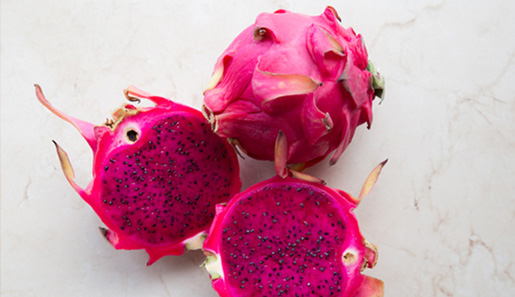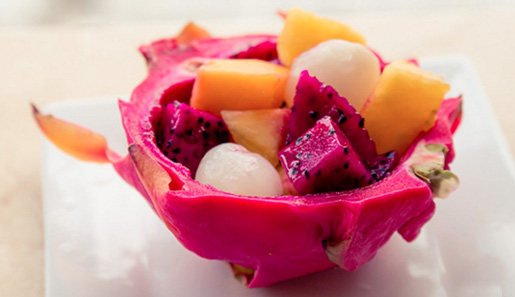 |
|
SPOTLIGHT |
|
|
|
|
|
| Dramatic, Delightful, and Delicious |
Bright and vibrant in color with a shape that is simultaneously unique and dramatic, dragon fruit can’t help but catch one’s eye. The most beautiful fruit in the cactus family is known by a host of other names including pitahaya, pitaya, night blooming cereus, strawberry pear, paniniokapunahouor papipi pua. Tasty and delicious as they are beautiful, dragon fruit have grown in popularity in recent years. Fortunately for us, they are now grown in many parts of Hawaii and are available in season in our stores.

Following are some things you may not know about this fabulous local fruit:
|
Top Pick: When selecting a dragon fruit, choose one with bright, evenly colored skin that yields gently to pressure. Fruits with brown spots or very dry looking stems are probably overripe. Dragon fruit do not ripen once picked. Store them in a refrigerator drawer for no more than a week or peel, cut and freeze them for up to 3 months.
A Gentle Dragon: The taste of a dragon fruit is juicy, creamy and refreshing, similar to that of kiwi mixed with pear. The flesh has black, edible seeds, like those in kiwi, scattered throughout. Most commonly cut in half and scooped out of its shell with a spoon, the fruit is also great in fruit salads, as an addition to juice, in preserves, pureed or frozen. Due to its delicate flavor, dragon fruit pairs well with other light flavors, like lychee or rose, but it also makes a nice contrast with bright, acidic fruits like pineapple. (See our featured recipe.)
Night Owl: The large, fragrant white flowers of the dragon fruit only bloom at night, typically from June to October. Flowers open rapidly in the early evening and flowering is complete by 10 PM. Pollination ceases in the wee hours of the morning and the flower then wilts. Fruit then form at the base of the wilted flower, on the long, snaky “arms” of the cactus plant, and will ripen in 5 to 6 weeks.
A Fruit of Many Colors: Local dragon fruit is primarily found in three varieties: pink/red-skinned with white interior flesh, red-skinned with red flesh and yellow-skinned with white flesh. Some say that the more intensely red the fruit, the sweeter the taste, while others insist the yellow-skinned, white-fleshed variety is so good that it tops all others.
Dragon-Sized Benefits: Dragon fruit is a superfood. High in vitamins, minerals, and antioxidants, it is also a good source of vitamin C, fiber, iron and calcium. It can protect against free radicals that cause aging, cancer, and disease, as well as support memory function and coordination and help foster a healthy immune system.

|
|
|
|
| Did You Know? |
 |
 |
| According to local lore, most of the red-outside, white-inside dragon fruit grown in Hawaii are descendants of the famed night-blooming cereus hedge that grows on the lava rock wall along Wilder Avenue, fronting Punahou School. Planted by Mrs. Sybil Bingham in 1836, the hedge attracted visitors from all over the island who stopped to see the glorious flowers in bloom during evenings from July to October. Some could not resist taking cuttings to plant for themselves, and dragon fruit plants began springing up across Hawaii. |
|
|
|
|
 |
|
RECIPES |
|
|
|
|
|
|
|
| It’s easy to make your own Pitaya (Dragon Fruit) Bowl! This dish is wonderfully refreshing and healthy too. Prepare it for your family and friends and you’ll make a dragon-sized impression! |
| INGREDIENTS |
- 1 average size red dragon fruit, peeled, diced 1 inch and frozen
- 1 cup mango, frozen
- ½ cup pineapple, frozen
- 1 banana plus ½ for slices
- ¾ cup almond or soy milk
- ¼ cup granola
- 2 strawberries, sliced
- ¼ cup blueberries
- 1 pinch goji berries
- 1 pinch shredded coconut
|
| INSTRUCTIONS |
- In a blender, combine the frozen dragon fruit, mango, pineapple, banana (peeled) and almond milk.
- Blend until smooth. If the blend it too thick, you may adjust with a little more milk.
- Pour into a soup bowl. Garnish with granola, banana slices, strawberry, blueberry, goji, and shredded coconut.
- Optional: Drizzle honey or agave on top.
Note: The pureed dragon fruit should be on the thick side so it can be eaten with a spoon. You can adjust the toppings to your own preference. You may also experiment with the fruit blends used in the blended puree. |
|
 |
| Did you make this recipe? |
| Let us know how it turned out for you! Share a picture on Instagram with the hashtag #FoodlandEatLocal |
|
| How can you tell it’s local? |
| Look for the ORANGE SIGNS |
| to find locally grown and locally made items throughout our stores. |
|
|
|
|
|
|
|

